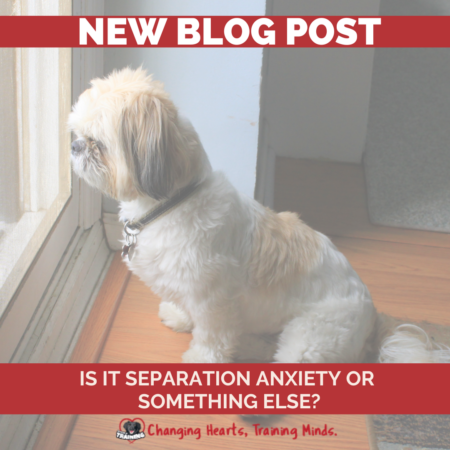It can be confusing for dog guardians to know if their dog or puppy is experiencing separation anxiety or just having normal “dog stuff” going on, since often there can be a lot of crossover between how behavior presents. Is the dog being destructive and shredding pillows because they’re anxious or because they’re bored? Are they barking in the crate because they’re just not fully comfortable in the crate or because they’re alone and confined? Are they having potty accidents due to anxiety, because they’re not really fully housebroken, because they have a medical issue like a UTI or did they just really have to go? These can all be challenging questions for owners to answer.
It’s especially tricky with puppies. Puppies naturally have separation anxiety. They vocalize as young puppies to reunite with mom, to communicate something, to get comfort or seek warmth. So it shouldn’t come as a surprise that a new puppy may vocalize when they come to their new home. Puppies also naturally do many things that can be indicators of separation anxiety including:
- vocalizing
- potty accidents
- destruction
- not liking confinement
How do we know the difference? And, what do we do about it? First, it’s incredibly important we don’t just let dogs just “cry it out,” as this can have grave consequences for their emotional wellbeing and for your relationship with your dog. If you are not sure if your dog is struggling with separation anxiety, you must assume they are and take steps to prevent them from possibly making it worse while you figure it out. This means suspending all absences until you are certain your dog does not have separation anxiety. I know this sounds impossible but it IS possible, as clients all over the world do it every day with their separation anxiety dogs. And remember, absence suspension is only temporary. Download my free guide: 26 Alternatives To Leaving Your Dog Alone.
Next, it’s time to do a short video assessment. Set up a video camera so you can watch and record a short (less than 5 minute) trial departure with the dog uncrated. You can set up a Zoom with your computer and then dial in with your phone (make sure it’s muted on your phone’s end so the dog can’t hear you) and you can watch and record. Or use any security or WiFi camera you have like a Wyze, Yi or Nest. Your departure must be real. You need to leave and be out of sight, not just sitting in your driveway. And your dog must not be confined. If at any time your dog is getting destructive, vocalizing extensively, having potty accidents, inflicting self-injury like chewing or licking, return immediately. Do not wait for 5 minutes to pass.
This video will help give us a clearer picture on things like confinement anxiety, FOMO (fear of missing out) and give us important footage of body language to review to make a determination about what’s going on and what the next steps are, whether that is working through separation anxiety training or addressing the other issues, like housetraining, enrichment, demand barking or medical issues. No matter what it is, don’t ignore it.
Recovery from separation anxiety is possible! Clients all over the world have successfully helped their dogs recover. One of my most recent graduates had this to say about her experience working with me:
Kate at Rescued by Training is absolutely everything you want in a trainer! I am so grateful to have found her for my separation anxiety rescue dog. When I started my SA training journey in February 2022, I knew NOTHING. I initially went to a veterinary behaviorist who used her own CSAT trainer, and we were NOT a good fit. While that trainer was highly educated, their style was as different from Kate’s as night and day. So I abandoned my initial team and found Kate at RBT and thank heavens I did. Not only is she highly educated, she is empathetic, an excellent communicator, provides LOADS of free resources (check them out now!!!), and she genuinely cared about me and my dog. She always made sure I understood her explanations and instructions and always asked if I had questions about anything at the end of our sessions. I really cannot recommend her enough. SA training (or any behavior issue) can be a rocky and emotional journey, and you want someone like Kate on your team. I’m happy to say my guy graduated quickly from her SA program! He has some other fear-related issues, and I’m looking forward to working with Kate again. (J.P./Google Reviews – Maryland)
If you’re not sure or need more guidance, or would like your dog to graduate from my program, set up your initial assessment today! Even if it’s not separation anxiety, I will help you get to the bottom of what’s going on!
Also, be sure to check out my self-paced Separation Anxiety Foundations course.
Happy training!
![]()




